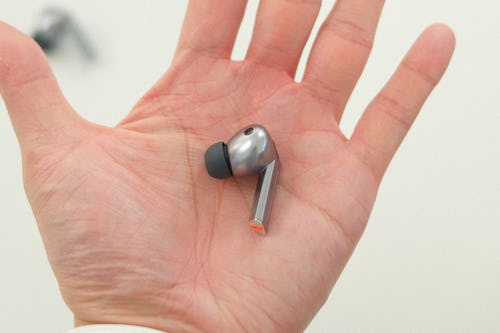
Anyone with a pair of working eyes can see the obvious: Samsung’s new Galaxy Buds 3 and Buds Pro 3 strongly resemble AirPods.
Sure, the charging case on Samsung’s wireless earbuds has a transparent top lid; they come in silver (in addition to white); the stems — sorry, blades — on the Buds 3 Pro light up for various functions. But come on, they look like AirPods. Naturally, the internet is roasting Samsung for copying Apple.
But Samsung says it didn’t copy its main consumer tech rival. At a media roundtable today, Patrick Chomet, EVP and Head of CX Office, Mobile eXperience Business, said copying AirPods “has never been a consideration,” and the North Star has been to make the best product for consumers from the start.
“I don’t care,” Chomet recalls telling Samsung’s product designers and engineers when they suggested people might compare the Buds 3s and AirPods. “I want the best product anyway, so we designed it to be the best for consumers. That’s the honest answer, and we may be exposed to criticisms, but I really don’t care because I just want the best product.”
Form Follows Function

Similarities in appearance aside, Chomet also had a nerdier answer for why Samsung redesigned the buds with stems. As I suggested in my original hands-on, though Apple was the first to release mainstream wireless earbuds with stems — a design that was widely ridiculed initially — the silhouette might actually be the best way to make wireless earbuds.
Chomet said the design of Buds 3 Pro started with engineering them for top-notch sound quality that would surpass the Galaxy Buds 2 Pro, and then creating the most optimal industrial design to deliver on that experience.
“We learned two things,” Chomet said when they started working on the Buds 3 Pro 18 months ago. “The sound is even more amazing because you separate the woofer and the speaker, and you need space for that. And then, this thing should understand your surroundings, and there will be a lot of AI to figure out how it works based on context.”
“It may look [like AirPods stems] on the surface, but it’s not the same at all. I can guarantee that.”
Those features are launching on the Buds Pro 3 in the form of drivers and speakers that can deliver 24-bit/96kHz hi-fi sound, with a frequency response range of up to 40kHz. In layman’s terms, that means more distinct separation between the lows, mids, and highs in your music, and reduced distortion at high volumes. On the AI front, the Buds 3 Pro have “Adaptive ANC,” which uses sound detection models to automatically adjust the ANC based on the types of sounds and levels of loudness in your environment. And with AI models, Samsung says the Buds 3 Pro can “restore” your voice during phone calls to nearly match the sound quality that you’d get directly from your phone’s earpiece. Essentially, the Buds 3 are doing some kind of upscaling to make your voice sound clearer over a Bluetooth connection, which transmits data at a lower sampling rate and makes audio sound tinny.
All of these improvements undoubtedly make for a better pair of wireless earbuds (and a reason to sell people new ones), but there’s another technical reason why the Buds 3 Pro needed “blades” to allow for better sound quality and AI-enabled features: ears.
Chomet said Samsung could have made the Galaxy Buds 3 without stems, and had working prototypes to prove it, but the high variation in ear shapes and sizes showed that features like Adaptive ANC and voice calling restoration on stem-less earbuds weren’t as good.

“We have a team that simulates thousands of ears from the whole planet, and that’s how we ended up with the blade,” Chomet said. “It may look [like AirPods stems] on the surface, but it’s not the same at all. I can guarantee that.”
According to Chomet, and as I suggested from my many years of reviewing wireless earbuds and touring earbuds testing labs, moving certain components like the microphones and controls to the stems and allowing more room for larger or additional speakers is form following function.
Samsung may look like a copycat, but other wireless earbuds makers, like Nothing, came to the same conclusion long ago. Apple just got it right from the start, which it deserves credit for. But at the same time, AirPods evolved from Bluetooth headsets, which essentially were long elongated stems that placed the microphone as close to your mouth as possible. And Bluetooth headsets were just smaller and wireless versions of telemarketing/teleconference headsets with their bendy mics. So today’s stem-equipped wireless earbuds really are just evolutions of what came long before them.
Samsung’s feeling the heat on full blast right now, but don’t be surprised if other wireless earbuds makers that have gone with a stem-less design add stems or blades of their own in future versions. It feels inevitable as companies integrate AI features and see the limitations of stem-less designs. You can’t exactly shove in cameras for AI-powered computer vision without stems.
FTTT
0 Comments